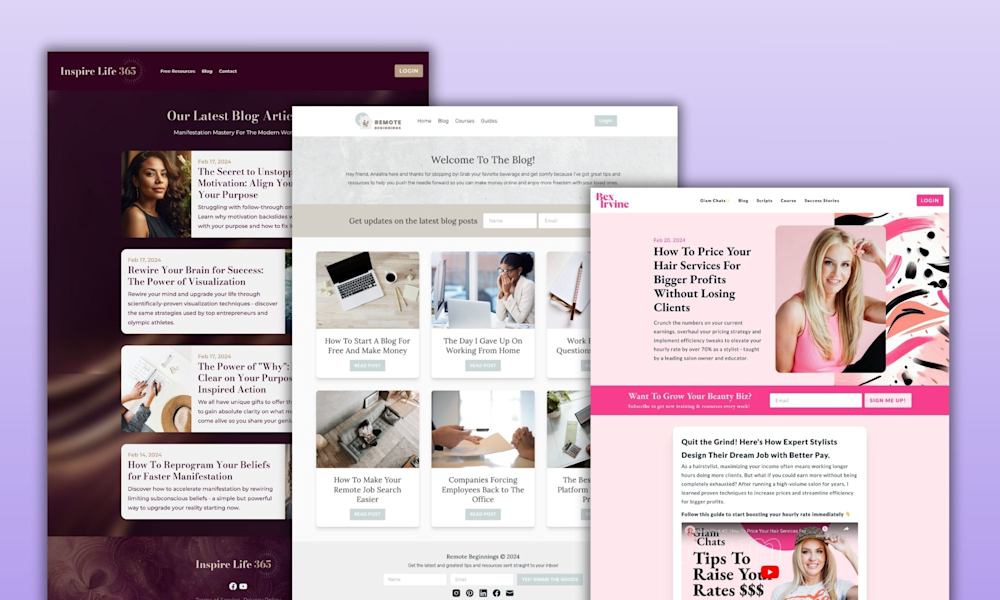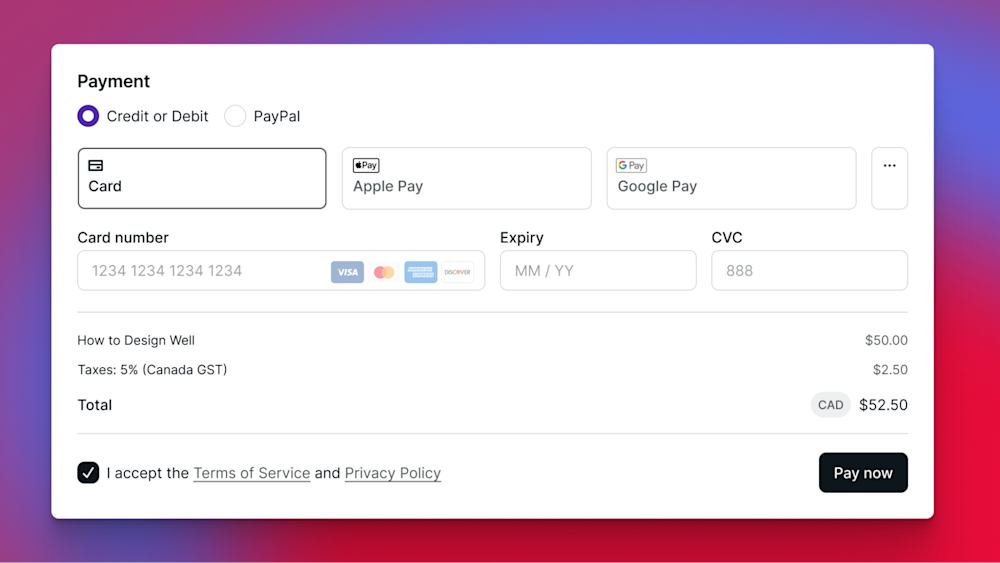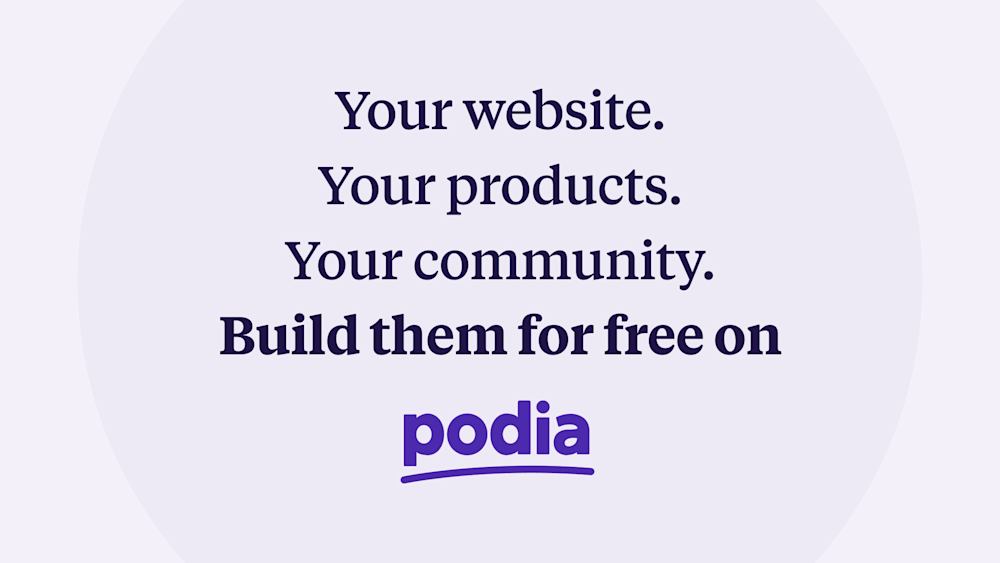What makes email — almost 50 years after the first marketing email was sent in 1978 — the most effective sales channel for online businesses?
The 2020s are the era of “the algorithm.” Social media platforms own audiences, promote the content they want to promote, remove content that “breaks” rules (even when it doesn’t), and generally change at a moment’s notice.
In the last couple of years alone, Instagram feeds became cluttered with suggested posts, TikTok has flirted with being banned, Twitch overhauled and then immediately rolled back sponsorship rules, YouTube changed monetization of videos with swearing, ChatGPT and AI have threatened the very nature of search engines and blog SEO, Reddit policies led to blackouts of major communities, and Twitter changed its name to “X.”
These networks can be incredible tools for growing an audience, and there are countless stories of creators who have had their lives changed by growth on a platform. But to rely solely on the good will of a giant platform is dangerous — and that’s why email marketing can’t be beat.
An email list is an audience you own. You can build it over time, take it with you when you switch tools, and send messages that people actually read (instead of being seen by 0.01% of your Facebook fans).
The email playbook of content to lead magnet to welcome series to email launch has persisted because it works. There’s no better way to communicate directly with your audience. No better way to show them your products. No better way to get sales.
With over 100,000 creators on Podia, we’ve seen people have phenomenal success with email. We’ve also seen that despite the power of email as a channel, email marketing platforms still have some frustrating problems. They’re hard to use, get messy over time, and most importantly — it’s a huge pain to get them to connect to the rest of your business.
Instead of having everything just work, you have to figure out how to get a new sale to trigger a new subscriber, who gets added to a list, who gets a specific tag, who gets added back to your main email list…it’s all an unnecessary headache.
Podia has had basic email marketing features for a while, but today we’re announcing a massive overhaul designed to take the headache out of owning your audience — and let you run your entire business from a single platform.
Podia Email adds a visual designer, filtering, segmentation, tags, forms, and automation. Everything you need to run your business in one place.
What does a great email platform need?
-
You have to be able to send beautiful emails. This is non-negotiable; your emails need to be customizable so that they can feel like yours. Starting from a professionally designed template is a bonus!
-
Your emails have to reach the right people. Segmentation gives you way more control over who you talk to and what you show them. It needs to be easy to segment your email list — and usually the hardest part is getting the right data.
-
You need automated email campaigns, so that you can reach your audience when they’re most interested in what you have to say. Welcome emails and automated launches take a massive burden off you, but they also help you sell more because they trigger when your audience is most likely to take action.
-
You need to connect it to the rest of your business. An email platform is no good without email addresses! Every platform has some way to get your subscribers into it — whether that’s forms, imports, or integrations — but the real question is what information you get alongside the email address. Ideally, your email marketing platform would have everything about a person’s history with you (what they’ve bought from you, what they’ve downloaded, how much they’ve spent).
When we set out to rebuild Podia Email, we knew you needed to be able to send beautiful emails, to the right people, automatically, in the same place as everything else.
So that’s what you can do. The new email builder lets you start from professionally designed templates, add (and link) images, use buttons, format text, choose fonts, change background colors, change text colors, customize headings, adjust email width, tweak line spacing, and generally make your emails look and feel the way you want them to look and feel.
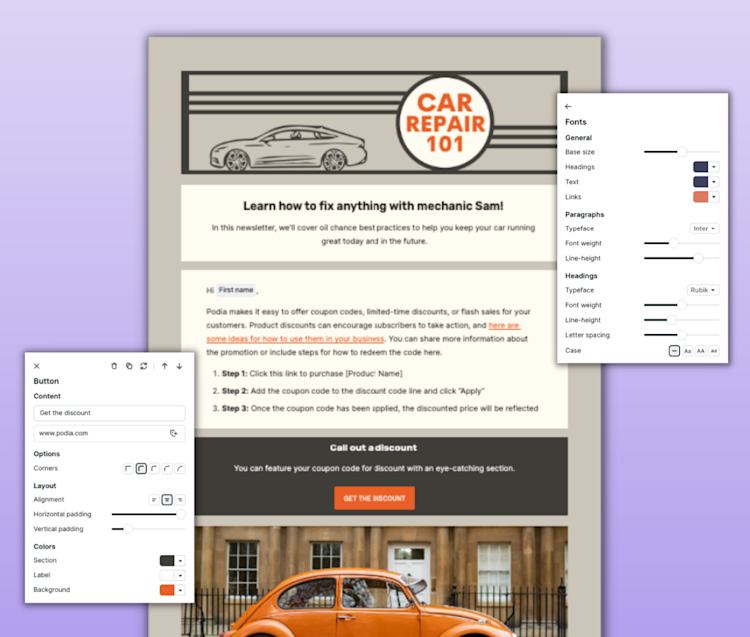
Segmentation and filtering are here too. And because Podia Email is in the same place as your website and products, there are some bonuses that are hard to find in other platforms.
-
You can see exactly how many sales you get (both number of sales and revenue) from each email.
-
Segments and filters let you filter your audience based on what products they have (or don’t have), when they signed up, how recently they were active, how much they’ve spent with your business, and other information that is hard or impossible to get into other platforms, even with Zapier or native integrations.
-
Tags are available through forms/link clicks — and most of the time you won’t even need to tag your subscribers. Because the important things (like product purchases) are tracked for you without additional setup.
-
Lead magnets are hosted in Podia as Podia products, and you can offer them through a Podia website or landing page. Nothing to stitch together!
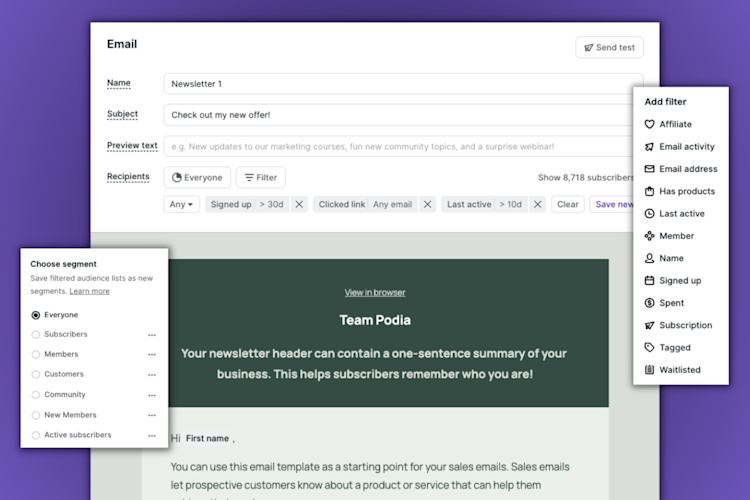
As you can see, this is a completely new product that completely changes how email works in Podia (and gives you new ways to use email marketing in your business). There are tons more features I haven’t mentioned here, and more still that we’re in the process of building.
And because of that, there’s also going to be a change to how Podia Email’s pricing works.
On August 31st, Podia Email will become an optional add-on to Podia
As of today, everyone who uses Podia will have full access to test out the new Podia Email platform and send as many emails as they like. On August 31st, Podia Email will become an optional, paid add-on to Podia (although anyone with under 100 subscribers will still have full access for free).
No one will be charged for Podia Email automatically. This is a fully opt-in add-on, and you won't be charged unless you sign up.
I know this is a change, and not an entirely pleasant one. It’s never ideal to have a platform change pricing, and right now a lot of platforms in the market are announcing price changes.
One of the things I value about Podia is that we try to be open and honest about the decisions we make and why, so I wanted to share some context about this decision and how we’ve been working to design pricing that’s as fair as possible.
-
The platform has to be great. You’re going to use email to communicate with your audience, and that means your messages have to look and feel like yours. The platform has to be easy to use, and it has to interact with everything else you have in Podia. We knew what we built would take a lot of resources, both to build initially and to keep improving over time — because it’s something you’re going to use to run your business.
-
Podia incurs a cost every time an email is sent from Podia, so it was never going to be sustainable to keep email as part of base Podia plans. But we wanted to get it right, and we’ve been working on this for two years — first to understand what would be fair, then to understand what we needed to build, and finally to build the new platform.
-
Whatever pricing we landed on would have to be fair. Podia is one of the most affordable platforms on the internet because anyone should be able to get the tools they need to start an online business.
The cost structure meant that we would need to eventually charge for email (both to cover costs, and to be able to keep investing in improving the platform). But rather than charge for the features Podia Email used to have — which, frankly, wasn’t something we felt comfortable charging for — we knew we had to build something that could compete with the rest of the market, feature for feature.
As an all-in-one platform, there was an opportunity to offer tools that other email products can’t at a price that other tools won’t.
To that end, we ultimately decided to price Podia Email based on the number of opted-in subscribers in your account (people with fewer than 100 subscribers get full access for free). As things stand, we’re pretty sure we’re the most affordable major email platform on the market, and you can see the full pricing here.
This is where we landed after considering four other serious options, and I wanted to share why we didn’t think those options would best serve you.
-
Keeping email as part of base Podia plans, without charging for email. Unfortunately, it costs money to send emails. As more and more people use Podia Email, the cost to operate Podia Email would increase — that would be unsustainable for Podia, but it would also prevent us from continuing to invest in the platform and building the new features you need.
-
Raising the price of Podia plans to offset the cost of email. I stand by Podia Email as an excellent product (that will only keep improving). But not everyone is going to want to use Podia Email, and that’s ok. You should be able to use whatever email platform you want, and baking the cost of Podia Email into base Podia plans would unfairly force some people to pay for a platform they don’t use.
-
Having a flat rate for a Podia Email add-on. Flat rates are uncommon for email platforms because the people who send the most emails are also the ones who run up costs. With a flat rate, that means that the smaller creators are subsidizing the larger ones! A flat rate also makes it harder for new people to get started (because the flat rate tends to be higher than entry price in other pricing models), which is the opposite of what we’re looking for.
-
Charging for the number of emails sent, instead of subscriber counts. There are a handful of platforms that charge based on emails sent instead of number of subscribers. We considered this option for a long time, but ultimately decided against it because it can create a lot of variability for your business and is hard to keep track of. You shouldn’t have to keep track of whether or not your bill is going to change every month, or weigh the decision to send a given email (and therefore have to pay more). Your audience is yours, and you should be able to communicate with them as often as you want without worrying about sending one too many emails.
Ultimately, pricing based on subscribers made the most sense.
Whichever pricing we chose would have to scale in some way with how much people use Podia Email — it’s the only way to have prices that are affordable for people just starting businesses but also fair for big senders (in a way that covers the cost of sending emails).
People with more subscribers also tend to send more emails, so pricing based on subscribers is the best way to keep the platform affordable for every stage of business.
Subscriber-based pricing also lets Podia keep unlimited monthly email sends. A lot of email platforms put a cap on the number of emails each month (even if you pay for subscribers). Podia Email doesn’t, because they’re your subscribers. You should be able to talk to them as much as you want.
As of today (until August 31st, 2023), everyone has full access to Podia Email regardless of your subscriber count.
If you’d like to migrate your email marketing from another platform, Podia is offering free migration services.
What have people like you done with Podia Email so far? Here are some examples from the 700+ beta testers
Before Podia Email was available to everyone, over 700 beta testers joined the new platform to report bugs, stress-test features, and suggest improvements. The result of that process has led to a more powerful platform, changes to make the interface easier to use, and the addition of new features — and our team is going to keep working on Podia Email as we keep getting feedback.
Podia Pros are tech experts who spend a lot of time using and comparing different platforms, so it was important to get their perspectives on the new Podia Email. Here’s what Pro Adrian Dalsus had to say about the new platform.
Designing a single email with images, gifs, buttons and formatting takes me about 30 min on another platform. In Podia Email it was half, and without leaving the platform where I have all my business. It’s extremely easy, like everything in Podia.
“I feel like Podia managed to simplify (and make exciting again) a process that the rest of the email marketing industry has made complicated. Creating a campaign or broadcast with Podia is as easy as writing an email in Gmail, but better.
Sending a simple email with any email marketing platform can mean wasting an hour configuring technical aspects, jumping from menu to menu, confirming and reconfirming details. Today, I feel like I’m genuinely one email and five minutes away from communicating with my audience.”
But you don’t have to be a pro to use Podia Email — and you shouldn’t have to be. Podia Email is designed so that anyone at all can create beautiful emails and send them to the right people.
The feedback from beta testers has been overwhelmingly awesome to read, so I wanted to share some of the emails they’ve been sending and what they have to say about the experience.
More to come (and how to enter the $2,000 August Fellowship)
This is still just the beginning of Podia Email. We’re going to keep working to make this platform the best it can be, so that you have more and more tools to grow your business.
As part of that work, it’s helpful to have as many of you as possible join in and give Podia Email a spin. That’s why entry into Podia’s August 2023 Fellowship (and a chance to win $2,000) is simple — all you have to do is send an email using Podia Email and you’ll be automatically entered to win. You don’t even have to fill out an application.
You can try Podia Email (and all of Podia's great features) free for 30 days.
I can’t wait to see the beautiful emails you’ll send. And, as always, I can’t wait to see what you’ll build next.

